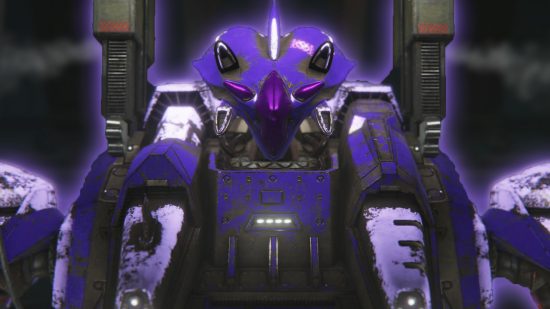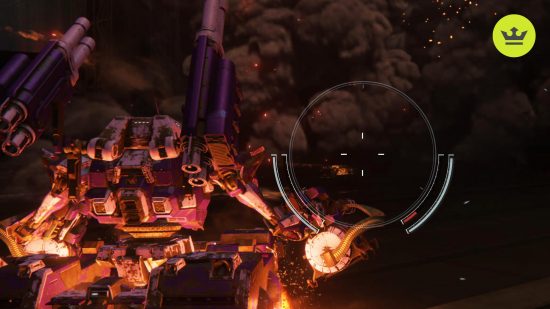Our Verdict
Armored Core 6 carefully synthesizes wanton destruction with a neatly-woven narrative that offers plenty of food for thought, despite being under-explored at points. Boasting a simple-yet-effective control scheme, and an expansive level of customization that never feels like it’s too much, FromSoftware has crafted a balanced experience that will definitely appeal to players, regardless of their experience with the mecha game genre.
Going into this Armored Core 6 review, I was filled with a giddy curiosity. It’s been a decade since FromSoftware launched its predecessor to middling reviews, but in that time the developer has grown exponentially, solidifying not only its formula for success through gripping soulslike experiences, but its reputation as one of the most consistently-brilliant studios in the modern era. As such, while Armored Core 6 isn’t a soulslike, I had very few doubts that FromSoft would be able to alchemize its learnings from Elden Ring into a blisteringly-fast, full-metal rave that can be played on repeat. Suffice to say, I wasn’t disappointed.
While The Lands Between paint a gorgeous, dark-fantasy world, Rubicon 3 is a far more uniform, yet equally-hostile environment. Whereas Elden Ring offers up opulent, golden trees, the only plants that are perennial in Armored Core 6 are power stations and mining installations that spindle out across the sky. Even beyond these hulking structures there’s little in the way of organic life, as most of the planet is coated in either barren desert or frigid tundra. It’s certainly not a hotspot for tourists.
The reasoning behind Rubicon’s largely-industrialized fascia is quickly established. At Rubicon’s core lies Coral – a mysterious, yet extremely-valuable substance that has drawn the attention of several extraplanetary corporations who wish to exploit it for their own gain. The corpos aren’t the only ones quarreling, however, as a native guerilla force – the Rubicon Liberation Front – seeks to defend the Coral from the warring factions.
Embodying the impersonally-named mercenary 621 – a fourth-generation augmented Armored Core (AC) pilot – your job isn’t to wade into interplanetary politics, it’s to sell your services to the highest bidder while leashed to your handler, Walter. The entire purpose of your existence revolves around profiting off of the profiteers, dehumanized to the extent that even your callsign, Raven, is simply a recycled tag passed down from former mercs.

As a further exercise in efficiency, even human interaction is barebones. For the most part, Armored Core 6’s dialog is delivered over voice comms by faceless figures who represent the various corporate entities you act on behalf of. It’s not a particularly enthralling narrative to begin with, though considering you’re simply a hunting dog, the less you know, the better.
While there’s a prevailing sense of detachment from the various powers on Rubicon, you are occasionally afforded agency through branching plot paths, as Raven begins to define what their moniker actually stands for. At first, I thought that the main crux of Armored Core 6’s narrative would solely revolve around Raven breaking the chains of corporate greed, but there’s much to be said about defining personal identity, too – FromSoft has once again showcased its ability to deftly weave a complex, multi-faceted narrative into its work. Conversely, condensing Armored Core’s narrative into a 15-20 hour runtime did leave me wanting to see its depths explored a little bit more, as I felt these themes were left unplumbed.
Admittedly, my first impressions of Rubicon itself were less-than-positive as my eyes struggled to adjust to what was being shown on-screen. The game’s opening passages plonked me down into sharp gray cityscapes that are classically Brutalist – Rubicon is an industrialized world without need of anything remotely superfluous, after all. However, discerning enemies from their surroundings was, at times, more difficult than some of the Armored Core 6 bosses, though a quick scour around with the targeting system eventually picked them up.
Trying to acclimate to a sea of steel is even more difficult when faced with the high level of motion blur FromSoft has injected into the game. While I appreciate the immersion it provides when you rapidly zoom towards a target, I don’t appreciate the fact I can’t turn it off or tone it down on PS5, making it uncomfortable to play at points – this is undoubtedly my biggest issue with AC6.
With that being said, and it’s hard to make it sound like I’m not romanticizing pedestrian environment design, Armored Core’s harsh landscapes making for uncomfortable viewing is kind of the point. Everything about Rubicon is sterile, yet abrasive. The sameness of its cities not only make sense narratively, but they also provide an innate challenge when it comes to keeping tabs on enemy locations.

Even beyond the mountains of metallic monoliths Rubicon doesn’t get much more forgiving. The heavy snowfall in some regions, as well as the sandstorms in others, aren’t reminders of an organic ecosystem to me – they’re an obstruction to my power fantasy. “I wish everything was flat concrete”, I found myself muttering several hours in, after I had full-sent a missile salvo into a raised dune. It was like trying and failing to chip a golf ball out of a bunker, except the ball is several hundred kilograms of explosive payload. Knowing FromSoft and its penchant for inflicting misery everywhere it can, this is all very much par for the course.
While Rubicon doesn’t inflect much in the way of its biomes, there is a delightful amount of variation in the various sorties you’re sent out on. Across the 40-or-so Armored Core 6 missions I embarked upon during my initial playthrough, I was seldom tasked with an objective I had completed before. In one instance I was protecting a huge installation from waves of enemies, while another required a feathery touch as I carefully wheeled my way past surveillance drones. In terms of scale, as often as I found myself mowing-down smaller MTs, I was scaling giant, marauding mining rigs or tackling other, much bigger ferrous fish than myself.
The game’s opening chapter is where you’ll find the most repetition, though it serves more as a primer for the numerous mechanics you will encounter while out in the field. It’s also a perfect time to get used to the controls, which thankfully feel incredibly intuitive on PS5. Here, you’re sent out on various sorties to try and collate clout with the corporations who take an increasing interest in your work.
As the narrative begins to open up, so too does Armored Core 6’s gameplay. You quickly begin to recognize that taking a somewhat methodical approach to your mech-murdering antics is much more beneficial than simply going in, guns-blazing – the latter option is way more fun, though. This is because elements like repairs and ammo costs are deducted from your pay.
Having said that, by the game’s mid-point, I found that I had more than enough cash to purchase whichever parts I needed, while the ability to sell parts for their buy price means there’s no real consequence for stocking up on sub-standard hardware. Additionally, the sortie fees are minimal, and I never once came out at a loss, even when utilizing some of the heaviest (and costliest) Armored Core 6 weapons. Back to guns-blazing, I suppose.
When you do find yourself flush with COAM (the game’s Euro-looking currency), your AC can quickly be turned into a far more-efficient machine of destruction. With my rapid ascent to affluence, I had cash to splash on pretty much anything I wanted from Armored Core 6’s impressive arsenal of armaments. ACs consist of 12 customizable slots, each boasting a plethora of parts from different manufacturers that sufficiently spoil you for choice.
Thanks to the options available – alongside the near-limitless paint and custom decal possibilities – I was able to fine tune my AC into pretty much anything I could imagine within its confines, be it cosplaying Overwatch’s Bastion, a mechanized version of Chainsaw Man, or getting creative with my own devilish contraption.
The Armored Core 6 weapons feel great, with each tool of your trade possessing a weightiness that’ll make you gleefully ooo and ahh with each pull of the trigger. It absolutely feels unfair to whimsically take a chainsaw to a group of enemies – forget Leatherface, it’s Metalface now – or to piledrive an MT that’s not even half the size of the weapon itself. Needless to say, when I finally clicked with AC6, my appetite for destruction couldn’t be quelled.
While I opted for a brute force build akin to that in our Armored Core Sea Spider boss guide for most of my playthrough, the game did well to temporarily impede my monotonous monstrosity with challenges that required switching my build up to overcome – AC6 won’t let you get away with taking the path of least resistance, and finding your own formula for success is incredibly satisfying.
The bosses themselves vary dramatically in difficulty, though for me this was chiefly decided by speed, ferocity, and navigating moments of sheer bullet hell, as opposed to groundbreaking mechanics – the game is predicated on unbridled aggression, after all. But while the average showdown with the game’s goliaths is but a flash in the pan compared to some of the Elden Ring bosses, the RPG’s DNA is all over its gun-toting cousin.
Exemplifying this, one boss utilized laser blades and was able to execute quick combos and plummeting attacks like Malenia with a couple nitrous tanks strapped to her back. Perhaps my favorite encounter, meanwhile, iterates on the General Radahn fight in how it ties AI support into the narrative.
Paying attention to a boss’ weaknesses and diligently filling up their Attitude Control System (ACS) bar to stagger them, while ensuring your own isn’t exploited, is crucial to mitigating the impact Armored Core 6’s scariest customers have during an encounter – Sekiro lead game designer-turned-AC6 game director Masaru Yamamura’s influence shines through. This might not be so pronounced during the story playthrough, but it most certainly is after the credits roll, and this is where the fun factor really gets dialed up.
You see, Armored Core 6 is a game that practically begs you to replay it. Up until the end of New Game++, FromSoft gradually adds more story branches and sorties, as well as challenge versions of existing sorties that require pushing your ability to min-max to its absolute limit. Missions and bosses you may have initially struggled with eventually become a walk in the park, as muscle memory and mech mastery combine like a Power Rangers’ Megazord to further amplify that absolutely ridiculous power fantasy AC6 fulfills.
Armored Core 6 is a lean, mean, mecha warmachine that delicately balances its various systems to make for an enjoyable and approachable return to FromSoft’s longest-running series. Its story may have required a few extra hours to really blossom, but it’s more than made up for with explosive action that’s well and truly in full-bloom, and can be easily enjoyed on repeat. Indeed, AC6 is sure to delight returning veterans, while providing an enjoyable and intuitive entry point for those pulling the trigger on the mecha genre for the first time.


